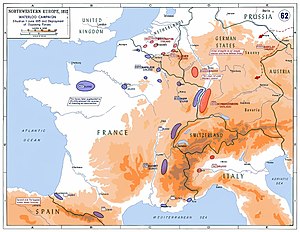| Minor campaigns of 1815 | |||||||
|---|---|---|---|---|---|---|---|
| Part of the War of the Seventh Coalition | |||||||
 Strategic situation in Western Europe in June 1815 | |||||||
| |||||||
| Belligerents | |||||||
|
|
Seventh Coalition: | ||||||
| Commanders and leaders | |||||||
|
|
von Hake | ||||||
On 1 March 1815 Napoleon Bonaparte escaped from his imprisonment on the isle of Elba, and launched a bid to recover his empire. A confederation of European powers pledged to stop him. During the period known as the Hundred Days Napoleon chose to confront the armies of Prince Blücher and the Duke of Wellington in what has become known as the Waterloo Campaign. He was decisively defeated by the two allied armies at the Battle of Waterloo, which then marched on Paris forcing Napoleon to abdicate for the second time. However Russia, Austria and some of the minor German states also fielded armies against him and all of them also invaded France. Of these other armies the ones engaged in the largest campaigns and saw the most fighting were two Austrian armies: The Army of the Upper Rhine and the Army of Italy.
The Battle of Waterloo, followed as it was by the advance of the armies of Blücher and Wellington upon Paris, was so decisive in its effects, and so comprehensive in its results, that the great object of the War — the destruction of the power of Napoleon Bonaparte and the restoration of the Bourbon Dynasty under King Louis XVIII on 8 July 1815 — was attained while the armies of the Upper Rhine and of Italy were but commencing their invasion of the French territory. Had the successes attendant upon the exertions of Blücher and Wellington assumed a less decisive character, and, more especially, had reverses taken the place of those successes; the operations of the Armies advancing from the Rhine and across the Alps would have acquired an immense importance in the history of the war: but the brilliant course of events in the north of France materially diminished the interest excited by the military transactions in other parts of France. The operations of the Confederation armies which invaded France along her eastern and south eastern frontier; afford a clear proof that amongst the more immediate consequences of the decisive Battle of Waterloo and speedy capture of Paris, was their having been the means of averting the more general and protracted warfare which would probably have taken place on these frontiers, had a different result in Belgium emboldened the French to act with vigour and effect a stronger defence of these parts of France.[1]

- ^ Siborne 1895, pp. 764, 779, 780.
